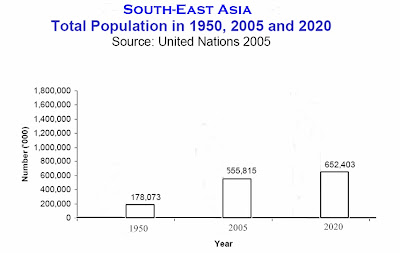Demographic characteristics of South-East Asia

Year back from now i was assigned to read about South-east Asia and Its demographic characteristics by my course teacher. I tried to gather information through various search engines Of all the changes that swept Southeast Asia over the three decades since the formation of ASEAN, the transformation of population processes and trends have been among the most striking. Southeast Asia in 2002 had 8.6 % of the world’s population with 536 million people compared with 7.2% in 1950 (population Reference Bureau, 2002). The post-war period has seen the population of Southeast Asia increase almost three times. The period following the formation of ASEAN has seen the population of the region double from 253 million. The regions population growth rate peaked at 2.52 % annum in the late 1960s up from 1.92 % in the early 1950s and subsequently falling to 1.4 % in 2002 (UNESCAP). However, the changes in the size and growth of the population are only part of the story, and there have been...


